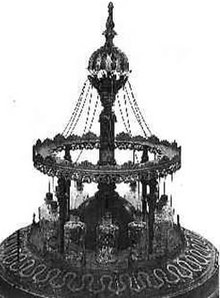
Michael Faraday was an English scientist who contributed to the study of electromagnetism and electrochemistry. His main discoveries include the principles underlying electromagnetic induction, diamagnetism and electrolysis. Although Faraday received little formal education, he was one of the most influential scientists in history. It was by his research on the magnetic field around a conductor carrying a direct current that Faraday established the concept of the electromagnetic field in physics. Faraday also established that magnetism could affect rays of light and that there was an underlying relationship between the two phenomena. He similarly discovered the principles of electromagnetic induction, diamagnetism, and the laws of electrolysis. His inventions of electromagnetic rotary devices formed the foundation of electric motor technology, and it was largely due to his efforts that electricity became practical for use in technology.

A barometer is a scientific instrument that is used to measure air pressure in a certain environment. Pressure tendency can forecast short term changes in the weather. Many measurements of air pressure are used within surface weather analysis to help find surface troughs, pressure systems and frontal boundaries.

The Great Exhibition of the Works of Industry of All Nations, also known as the Great Exhibition or the Crystal Palace Exhibition, was an international exhibition that took place in Hyde Park, London, from 1 May to 15 October 1851. It was the first in a series of World's Fairs, exhibitions of culture and industry that became popular in the 19th century. The event was organised by Henry Cole and Prince Albert, husband of Victoria, Queen of the United Kingdom.
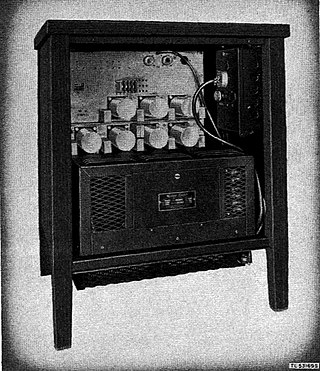
TEMPEST is a U.S. National Security Agency specification and a NATO certification referring to spying on information systems through leaking emanations, including unintentional radio or electrical signals, sounds, and vibrations. TEMPEST covers both methods to spy upon others and how to shield equipment against such spying. The protection efforts are also known as emission security (EMSEC), which is a subset of communications security (COMSEC).

Joseph Henry was an American scientist who served as the first Secretary of the Smithsonian Institution. He was the secretary for the National Institute for the Promotion of Science, a precursor of the Smithsonian Institution.

Antonio Santi Giuseppe Meucci was an Italian inventor and an associate of Giuseppe Garibaldi, a major political figure in the history of Italy. Meucci is best known for developing a voice-communication apparatus that several sources credit as the first telephone.

A diorama is a replica of a scene, typically a three-dimensional full-size or miniature model, sometimes enclosed in a glass showcase for a museum. Dioramas are often built by hobbyists as part of related hobbies such as military vehicle modeling, miniature figure modeling, or aircraft modeling.

A eudiometer is a laboratory device that measures the change in volume of a gas mixture following a physical or chemical change.

The invention of the telephone was the culmination of work done by more than one individual, and led to an array of lawsuits relating to the patent claims of several individuals and numerous companies.

Captain George William Manby FRS was an English author and inventor. He designed an apparatus for saving life from shipwrecks and also the first modern form of fire extinguisher.
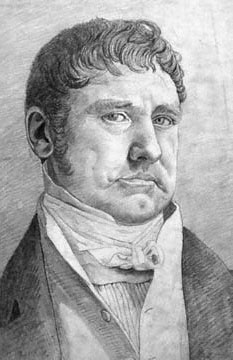
Cornelius Varley, FRSA was a British water-colour painter and optical instrument-maker. He invented the graphic telescope and the graphic microscope.
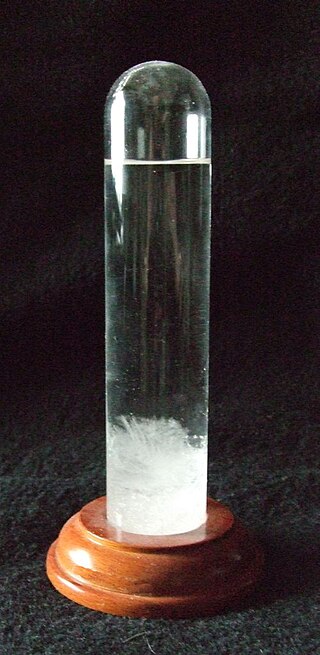
The storm glass or chemical weather glass was an instrument claimed to help predict weather. It consists of a special liquid placed inside a sealed transparent glass. The state of crystallization within the liquid was believed to be related to the weather. The inventor is unknown but the device became popular in the 1860s after being promoted by Royal Navy Admiral Robert FitzRoy who claimed that
if fixed, undisturbed, in free air, not exposed to radiation, fire, or sun, but in the ordinary light of a well-ventilated room or outer air, the chemical mixture in a so-called storm-glass varies in character with the direction of the wind, not its force, specially from another cause, electrical tension.
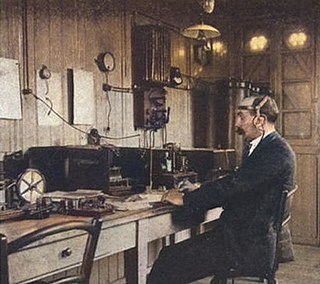
The invention of radio communication was preceded by many decades of establishing theoretical underpinnings, discovery and experimental investigation of radio waves, and engineering and technical developments related to their transmission and detection. These developments allowed Guglielmo Marconi to turn radio waves into a wireless communication system.
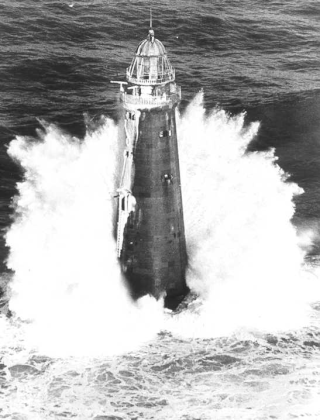
Minot's Ledge Light, officially Minots Ledge Light, is a lighthouse on Minots Ledge, one mile offshore of the towns of Cohasset and Scituate, Massachusetts, to the southeast of Boston Harbor. It is a part of the Town of Cohassett, in Plymouth County. The current lighthouse is the second on the site, the first having been washed away in a storm after only a few months of use.

A dynamo is an electrical generator that creates direct current using a commutator. Dynamos were the first electrical generators capable of delivering power for industry, and the foundation upon which many other later electric-power conversion devices were based, including the electric motor, the alternating-current alternator, and the rotary converter.

Merryweather & Sons of Clapham, later Greenwich, London, were builders of steam fire engines and steam tram engines.
George Merryweather was a British doctor and inventor.
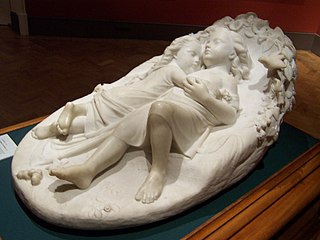
John Bell (1812–1895) was a British sculptor, born in Bell's Row, Great Yarmouth, Norfolk. His family home was Hopton Hall, Suffolk. His works were shown at the Great Exhibition of 1851, and he was responsible for the marble group representing "America" on the Albert Memorial in London.
Barometer World is the world's only barometer museum, and is located in the village of Merton, near Great Torrington, Devon, England. Barometer World makes, sells and restores barometers of a variety of types. It was established in 1979 by Philip Collins.

Thomas Thorp (1850–1914) was an English manufacturer of scientific instruments credited with inventing the first practical coin-in-the-slot gas meter, with innovations in the field of photography, including that involving colour, and for producing an early example of what has since been developed into the modern spectrohelioscope. He began his working life as an apprentice to a firm of architects and ended it as a Fellow of the Royal Astronomical Society, having had a keen interest in astronomy since childhood.
